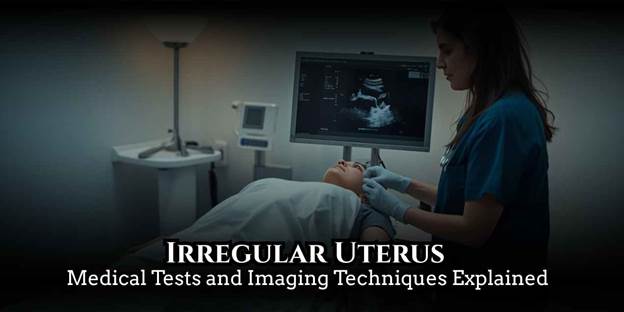An irregular uterus can manifest in various forms from structural abnormalities to size variations and identifying these conditions requires precise diagnostic approaches. Modern medicine offers a comprehensive range of uterine imaging techniques and medical tests that provide clear insights into uterine health.
This article explores the essential diagnostic procedures used to detect uterine abnormalities, including ultrasounds, MRI scans, hysteroscopy, and specialized examinations. Whether you’re investigating symptoms or preparing for fertility treatment, understanding these diagnostic methods empowers you to have informed conversations with your healthcare provider and make confident decisions about your reproductive health. Discover how medical professionals accurately identify uterine irregularities and what each test can reveal about your condition.
What Is an Irregular Uterus?
An irregular uterus refers to any deviation from the typical pear-shaped structure of the uterine cavity. These variations can include congenital malformations, acquired conditions like fibroids, or changes in uterine shape and size. Uterine abnormalities affect approximately 3-5% of women and can impact menstrual cycles, fertility, and pregnancy outcomes. Understanding your uterine structure begins with accurate diagnosis, which is why medical professionals rely on advanced imaging and testing methods.
The uterus can be irregular due to several factors:
- Congenital conditions present from birth, such as a septate or bicornuate uterus
- Benign growths like fibroids or polyps that alter the uterine shape
- Endometriosis causing tissue growth outside the uterus
- Adenomyosis where endometrial tissue grows into the uterine wall
- Scarring from previous surgeries or infections
Primary Diagnostic Methods for Detecting Uterine Issues
Transvaginal Ultrasound
This is typically the first-line diagnostic tool for evaluating an irregular uterus. A transvaginal ultrasound uses high-frequency sound waves to create detailed images of the uterine structure. The procedure is non-invasive, painless, and provides real-time visualization of the uterus, ovaries, and surrounding tissues.
Benefits of ultrasound imaging include:
- No radiation exposure, ensuring it’s completely safe for multiple examinations
- Cost-effective compared to other imaging techniques
- Immediate results during the examination
- Ability to assess blood flow to the uterus
- Detection of fibroids, polyps, and ovarian cysts
Magnetic Resonance Imaging (MRI)
When ultrasound results are inconclusive or more detailed visualization is needed, MRI becomes the gold standard. This uterine imaging technique provides exceptional soft tissue contrast and can precisely map the anatomy of an irregular uterus. MRI is particularly valuable for diagnosing congenital uterine anomalies and distinguishing between different types of abnormalities.
Hysterosalpingography (HSG)
This specialized X-ray procedure evaluates the uterine cavity and fallopian tubes. A contrast dye is injected through the cervix, highlighting the internal contours of the uterus. HSG is especially useful for women undergoing fertility treatment as it can identify blockages or structural issues affecting conception.

Advanced Diagnostic Procedures
Hysteroscopy
Hysteroscopy allows direct visualization of the uterine cavity through a thin, lighted telescope inserted through the cervix. This procedure can be both diagnostic and therapeutic, as doctors can remove polyps or fibroids during the same examination.
Key advantages include:
- Direct visual confirmation of abnormalities
- Ability to take tissue samples for biopsy
- Treatment can occur simultaneously with diagnosis
- Minimal recovery time with outpatient procedures
Sonohysterography
Also called saline infusion sonography, this enhanced ultrasound technique involves injecting sterile saline into the uterine cavity. The fluid expands the cavity, providing clearer images of the uterine lining and any irregularities. This method effectively identifies polyps, submucosal fibroids, and adhesions that standard ultrasounds might miss.
When Should You Seek Diagnostic Testing?
Recognizing symptoms that warrant investigation is crucial for early detection. Consider consulting your healthcare provider if you experience:
- Abnormally heavy or prolonged menstrual bleeding
- Severe pelvic pain or cramping
- Difficulty conceiving after 12 months of trying
- Recurrent miscarriages
- Unusual bleeding between periods or after menopause
Preparing for Your Diagnostic Appointment
Understanding what to expect can ease anxiety about uterine testing. Most procedures require minimal preparation, though timing during your menstrual cycle may be important. Your doctor will provide specific instructions based on the chosen diagnostic method.
General preparation tips:
- Schedule tests during the follicular phase (days 5-12 of your cycle) when possible
- Notify your healthcare provider of any allergic reactions, particularly to imaging contrast materials
- Discuss medications you’re taking, particularly blood thinners
- Ask about pain management options for invasive procedures
- Arrange transportation if sedation is required
Interpreting Your Results
After diagnostic testing, your healthcare provider will explain the findings and discuss treatment options if an irregular uterus is confirmed. Results may reveal benign conditions requiring monitoring, or they might indicate interventions like medication, minimally invasive procedures, or surgery. The diagnostic journey provides clarity and direction for managing your reproductive health effectively.
Conclusion
Diagnosing an irregular uterus requires a combination of advanced medical tests and uterine imaging techniques that provide accurate insights into your reproductive health. From initial ultrasounds to detailed MRI scans and hysteroscopy, these diagnostic tools empower healthcare providers to identify uterine abnormalities precisely and develop effective treatment plans. Early detection through proper testing can significantly improve fertility outcomes and overall wellbeing. If you’re experiencing symptoms or have concerns about your uterine health, don’t hesitate to consult your healthcare provider. Understanding your diagnosis is the first step toward taking control of your reproductive journey and exploring appropriate treatment options tailored to your needs.





